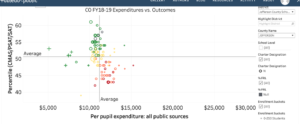With more than $1.1 billion in stimulus dollars flowing into Colorado school districts over the next year, the big question is: will the students in greatest need of support get it, and in what form?
We know through a variety of national studies and anecdotal reports that far too many students have experienced enormous trauma and learning loss over the last year, with the most vulnerable students being hit the hardest. A recent study by McKinsey showed that the existing learning gaps by race and income have grown dramatically since the start of the pandemic, while rates of depression and anxiety have increased among students.
While it is too early to know how Colorado districts are going to target these federal stimulus dollars to better support students, thanks to some recent federal data analysis by Professor Margarite Rosa of Georgetown University, we can see whether districts were able to direct existing funding to the schools with the students with the greatest needs.
The Edunomics Lab at Georgetown recently released a variety of data that can be accessed here that shows all Colorado schools with a plot of test percentile vs. per pupil spending at the school level for fiscal year 2018-19.
These plots enable one to see whether the schools with highest percentages of low-income students are getting more funding (and how much) while also showing the relative return on investment for money spent and academic test score gain.
There are several interesting takeaways from looking at the three districts in the Denver Metro area with the largest numbers of low-income, Latinx and Black students — Denver, Aurora and Jefferson County.
In reviewing the plots for DPS, there is an enormous spread on funding for elementary schools. For example, Denver Language School, a dual language charter received the lowest level of funding at $8,340 per student while Hallett elementary, a district managed school, received $19,982 per student, nearly twice as much.
Denver’s Scatter Plot
The good news for Denver is that because of student-based budgeting formulas that push more funds to the schools with higher percentages of low-income, English Language Learners and special education students, these schools are receiving significantly more funding than schools with mostly middle-income students. Denver appears to have one of if not the largest spread of funding by school with the trend for more funding tied directly to student population of the school.
So how are Denver’s large neighboring districts, JeffCo and Aurora doing?
In Aurora for the same plot of district elementary schools, the spread of spending is narrower with schools more bunched up around the average spending for the district at $12,336 per student. Charter schools appear to get less funding, with the lowest spending of all elementary schools in Aurora at the Academy of Advanced Learning at $8,745. Aurora’s school with the most spending is the district-run Montview Academy of Math and Science at $13,776.
JeffCo, which has about 25,000 low-income students, spends less than Aurora and Denver with the average per pupil spending at $11,183. The spread for spending in JeffCo is the least of the three districts even though the range of student populations in schools is similar to Denver and Aurora, with many JeffCo schools being segregated and with most low-income students concentrated in particular schools.
JeffCo has some outlier schools on both ends of the spending spectrum, with the lowest spending in at Wilson Charter School at $5,140, and the highest spending at Peak Expeditionary at $15,258. The more typical spread for non-low-income vs low-income schools is $2,000 which is far less than Denver, where the spread- is approximately $4,000.
Jeffco’s Scatter Plot
So, what does this all mean for the stimulus funding? It is hard to know until we see where the money was directed in the coming years, but I am guessing the same patterns will follow as in 2019.
Denver and Aurora are likely to more carefully target spending to the kids who most need it, while JeffCo is likely to more evenly spread out the stimulus funding, which means the students that most need it will end up with less support.






